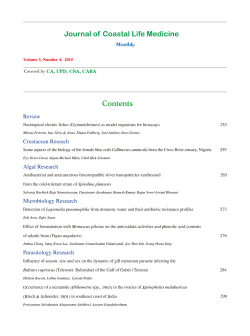
dune changes and its impact at digha coast of west bengal
International Journal of Social Science & Interdisciplinary Research__________________________________ ISSN 2277-3630 IJSSIR, Vol. 4 (4), APRIL (2015), pp. 37-43 Online available at indianresearchjournals.com DUNE CHANGES AND ITS IMPACT AT DIGHA COAST OF WEST BENGAL NIRMALYA DAS ASSISTANT PROFESSOR, PANSKURA BANAMALI COLLEGE, PURBA MEDINIPUR-721152, WB, INDIA. ABSTRACT Coastal zones are geomorphologically dynamic, ecologically sensitive, biologically productive and environmentally hazard prone under the events of cyclones and tidal waves. In present day the coastal areas stands as a collision course between the two ways changes – expected natural changes and human related developmental changes. The developmental activities in coastal areas are introduced for many purposes like tourism, construction of sea port and fishing harbours etc. contributes to habitat loss in many ways such as destruction of dunes, wetlands, coastal vegetations, soils and by filling and dumping of wastes. Viewing these aspects, Digha coast as an important sea resort of West Bengal has been taken as an important area of study for both natural changes and changes due to anthropogenic activities. The cyclones and tidal waves caused a significant lowering of beach surface of Digha coastal area. The changes of dunes and lowering of beach at Digha coastal area influenced on the permanent settlements of the coastal villages. The changes and alteration of dunes has been analyzed from both natural and anthropogenic view point and shows its impact on shelter-environment problem of coastal villages. KEY WORDS: Coastal dunes, beach lowering, anthropogenic activities, shelter-environment problem, coastal zone management. REFERENCE: 1. Bhattacharya, A. and Sarkar, S.K (1996) Study on salt marsh and associated meso-tidal beach faces variation from the coastal zone of eastern India. Proceedings of the International conference on Ocean Engineering COE’96 IIT Madras, India.Dec.1996, Allied pub. Ltd., Chennai, pp.475-479 2. Bhattacharya, A. 2001. Sedimentary structures in the transitional zone between inter tidal and supratidal flats of the mesotidal tropical coast of eastern India. Proc. Tidalties (2000), (Eds Y.A.Park and R.A. Davis, Jr.), The Korean society of oceanography, pp. 47-54. 3. Bhattacharya, A. Sarkar, S. and Bhattacharya, A. (2003), An assessment of coastal modification in the lowlying tropical coast of northern India and role of natural and artificial International Journal of Social Science & Interdisciplinary Research__________________________________ ISSN 2277-3630 IJSSIR, Vol. 4 (4), APRIL (2015), pp. 37-43 Online available at indianresearchjournals.com forcing international conference on Estuaries and coasts, November 9-11, 2003,Hangzhou, China. 4. Friedman, G.M. and Sanders, J.E. (1978) Principles of sedimentology. John Willy, New York, 792p. 5. Goswami, A.B. and Chakraborty,P. (1989), Quaternary geology and geomorphology of the coastal plains of Medinipur district, west Bengal, India, with special reference to formprocess- material-event, (IGCP218). Quaternary process and Events in South East Asia, Geological Survey of India, Calcutta. 6. Niyogi,D.(1970) Geological Background of beach erosion at Digha, West Bengal, Bulletin of Geological Mining and Metallurgical society of India,vol-43,pp.1-36.
© Copyright 2025












